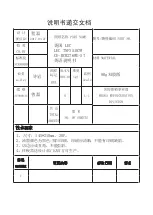
9
■
To help remove odors, you can wash interior walls with a
mixture of warm water and baking soda (2 tbs to 1 qt
[26 g to 0.95 L] of water).
4.
Wash stainless steel and painted metal exteriors with a clean
sponge or soft cloth and a mild detergent in warm water. Do
not use abrasive or harsh cleaners, or cleaners containing
chlorine. These can scratch or damage materials. Dry
thoroughly with a soft cloth.
NOTE:
To keep your stainless steel refrigerator looking like
new and to remove minor scuffs or marks, it is suggested that
you use the manufacturer’s approved Stainless Steel Cleaner
and Polish. To order the cleaner, see “Accessories.”
IMPORTANT:
This cleaner is for stainless steel parts only!
Do not allow the Stainless Steel Cleaner and Polish to come
into contact with any plastic parts such as the trim pieces,
dispenser covers or door gaskets. If unintentional contact
does occur, clean plastic part with a sponge and mild
detergent in warm water. Dry thoroughly with a soft cloth.
5.
Replace the removable parts.
6.
Clean the condenser coils regularly. They are located behind
the base grille. Coils may need to be cleaned as often as
every other month. This may help save energy.
■
Remove the base grille. See “Base Grille.”
■
Use a vacuum cleaner with an extended attachment to
clean the condenser coils when they are dusty or dirty.
■
Replace the base grille.
7.
Plug in refrigerator or reconnect power.
Vacation and Moving Care
Vacations
If you choose to leave the refrigerator on while you’re away, use
up any perishables and freeze other items.
If you choose to turn the refrigerator off before you leave, follow
these steps.
1.
Remove all food from the refrigerator.
2.
Unplug the refrigerator.
3.
Clean the refrigerator. See “Cleaning.”
4.
Tape a rubber or wood block to the top of the door to prop it
open far enough for air to get in. This stops odor and mold
from building up.
Moving
When you are moving your refrigerator to a new home, follow
these steps to prepare it for the move.
1.
Remove all food from the refrigerator.
2.
Unplug the refrigerator.
3.
Clean, wipe, and dry it thoroughly.
4.
Take out all removable parts, wrap them well, and tape them
together so they don’t shift and rattle during the move.
5.
Tape the doors shut and tape the power cord to the back of
the refrigerator.
When you get to your new home, put everything back and refer to
the “Installation Instructions” section for preparation instructions.
TROUBLESHOOTING
Try the solutions suggested here first in order to avoid the
cost of an unnecessary service call.
Your refrigerator will not operate
■
Is the power supply cord unplugged?
Plug into a grounded
3 prong outlet.
■
Has a household fuse blown, or has a circuit breaker
tripped?
Replace the fuse or reset the circuit.
■
Is the Refrigerator Control in Cool Off mode?
See “Using
the Controls.”
The motor seems to run too much
■
Is the temperature outside hotter than normal?
Expect the
motor to run longer under warm conditions. At normal
outdoor temperatures, expect your motor to run about 40%
to 80% of the time. Under warmer conditions, expect it to run
even more of the time.
■
Has a large amount of food just been added to the
refrigerator?
Adding a large amount of food warms the
refrigerator. It is normal for the motor to run longer in order to
cool the refrigerator back down.
■
Is the door opened often?
Expect the motor to run longer
when this occurs. In order to conserve energy, try to get
everything you need out of the refrigerator at once, keep food
organized so it is easy to find, and close the door as soon as
the food is removed.
■
Is the control set correctly for the surrounding
conditions?
See “Using the Controls.”
Electrical Shock Hazard
Plug into a grounded 3 prong outlet.
Do not remove ground prong.
Do not use an adapter.
Do not use an extension cord.
Failure to follow these instructions can result in death,
fire, or electrical shock.
WARNING










































